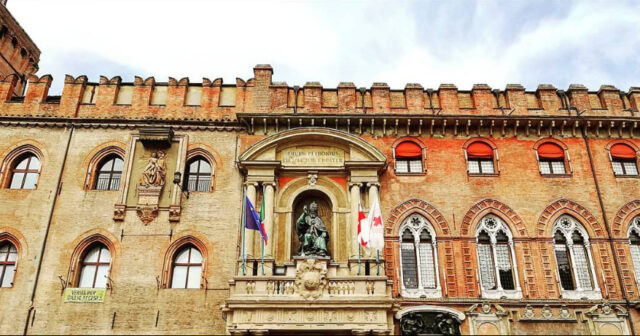Palazzo Comunale
The Palazzo Comunale in Piazza Maggiore consists of a group of buildings that over the centuries have gradually been merged with an older nucleus acquired by the Municipality at the end of the thirteenth century. That first nucleus was acquired by among others of Don Accursio (the Palazzo is also known as Palazzo d’Accursio), a renowned professor of law in 13th-century Bologna.
The palazzo was initially intended to serve as a public grain storage and house some municipal offices; since in 1336, it became the residence of the city’s Elders, the highest government judiciary of the Municipality.
Renovated and enlarged in the first half of the fifteenth century, it was then enriched with a clock in the Accursio tower and, according to widespread examples in central Europe, a carousel with wooden automata (Madonna with Child and procession of the Magi) which was removed in 1796 (a few remain, preserved today in the Municipal Art Collections, on the second floor).


The increasingly strong presence of papal power in the city, already evoked by the copper foil statue of Boniface VIII (1301, now kept in the Medieval Museum) placed on the facade, above the railing of the Elders, led to substantial architectural revisions, starting from 1506, with the arrival of Pope Julius II, at the time of the fall of the tyrant Giovanni II Bentivoglio.
The monumental rooms inside the palazzo preserve the memory of historical moments and political events of Bologna. On the first floor, there is a second gallery, used today as the Town Council Hall, whose vault was frescoed between 1675 and 1677 by Angelo Michele Colonna and Gioacchino Pizzoli for the Bolognese Senate. The Hall was adorned with architectural quadratures and allegories alluding to wealth, the city’s fame, arts, and culture.
On the second floor, the Chapel of the Legate overlooks the large Sala Farnese, where a solemn ceremony was held in 1530 for the coronation of Emperor Charles V. In the chapel, frescoes with Stories from the life of the Virgin, executed by Prospero Fontana ( 1562) represent one of the most important expressions of Bolognese painting, a school with elements from both Mannerism and the Counter-Reformation.


The decoration of the Sala Farnese, carried out around 1660 by a group of artists of a generation following that of Francesco Albani, retraces the salient moments of the presence of the Church and papal power in the city, through the representation of episodes ranging from the Middle Ages to the seventeenth century.
The room leads to the Municipal Art Collections, founded in 1936, which preserve paintings and furnishings from the Middle Ages to the 19th century, and to the Morandi Museum, inaugurated in 1993, whose heritage is largely made up of works donated to the Town Hall by the artist’s family.
The Collezioni Comunali d’Arte of Bologna, the highlight of Palazzo Comunale, was in essence created from donations of paintings, furniture, and furnishings received by the Municipality of Bologna during the nineteenth and early twentieth centuries, which enriched the ancient collection belonging to the city’s magistrates from the thirteenth to the early twentieth century. There are works from the Middle Ages originally included in the medieval section of the Civic Museum.
Overall the Palazzo D’Accursio is the seat of the city’s Municipal Authority since 1336 and a must-visit of Piazza Maggiore in Bologna.



